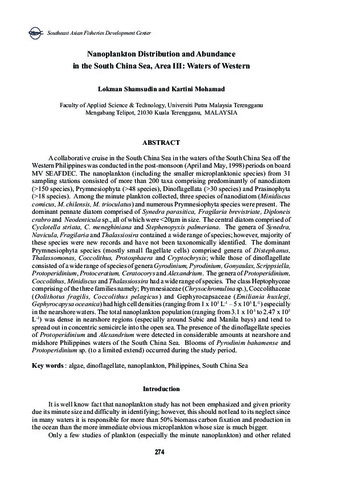| dc.identifier.citation | Shamsudin, L., & Mohamad, K. (2000). Nanoplankton distribution and abundance in the South China Sea, Area III: Waters of Western. In Proceedings of the Third Technical Seminar on Marine Fishery Resources Survey in the South China Sea, Area III: Western Philippines, 13-15 July 1999 (pp. 274-290). Bangkok, Thailand: Secretariat, Southeast Asian Fisheries Development Center. | en |
| dc.description.abstract | A collaborative cruise in the South China Sea in the waters of the South China Sea off the Western Philippines was conducted in the post-monsoon (April and May, 1998) periods on board MV SEAFDEC. The nanoplankton (including the smaller microplanktonic species) from 31 sampling stations consisted of more than 200 taxa comprising predominantly of nanodiatom (>150 species), Prymnesiophyta (>48 species), Dinoflagellata (>30 species) and Prasinophyta (>18 species). Among the minute plankton collected, three species of nanodiatom (Minidiscus comicus, M. chilensis, M. trioculatus) and numerous Prymnesiophyta species were present. The dominant pennate diatom comprised of Synedra parasitica, Fragilaria brevistriate, Diploneis crabro and Neodenticula sp., all of which were <20?m in size. The central diatom comprised of Cyclotella striata, C. meneghiniana and Stephenopyxis palmeriana. The genera of Synedra, Navicula, Fragilaria and Thalassiosira contained a wide range of species; however, majority of these species were new records and have not been taxonomically identified. The dominant Prymnesiophyta species (mostly small flagellate cells) comprised genera of Distephanus, Thalassomonas, Coccolithus, Protosphaera and Cryptochrysis; while those of dinoflagellate consisted of a wide range of species of genera Gyrodinium, Pyrodinium, Gonyaulax, Scrippsiella, Protoperidinium, Protoceratium, Ceratocorys and Alexandrium. The genera of Protoperidinium, Coccolithus, Minidiscus and Thalassiossira had a wide range of species. The class Heptophyceae comprising of the three families namely; Prymnesiaceae (Chrysochromulina sp.), Coccolithaceae (Oolithotus fragilis, Coccolithus pelagicus) and Gephyrocapsaceae (Emiliania huxlegi, Gephyrocapysa oceanica) had high cell densities (ranging from 1 x 105 L-1 - 5 x 105 L-1) especially in the nearshore waters. The total nanoplankton population (ranging from 3.1 x 105 to 2.47 x 105 L-1) was dense in nearshore regions (especially around Subic and Manila bays) and tend to spread out in concentric semicircle into the open sea. The presence of the dinoflagellate species of Protoperidinium and Alexandrium were detected in considerable amounts at nearshore and midshore Philippines waters of the South China Sea. Blooms of Pyrodinim bahamense and Protoperidinium sp. (to a limited extend) occurred during the study period. | en |

